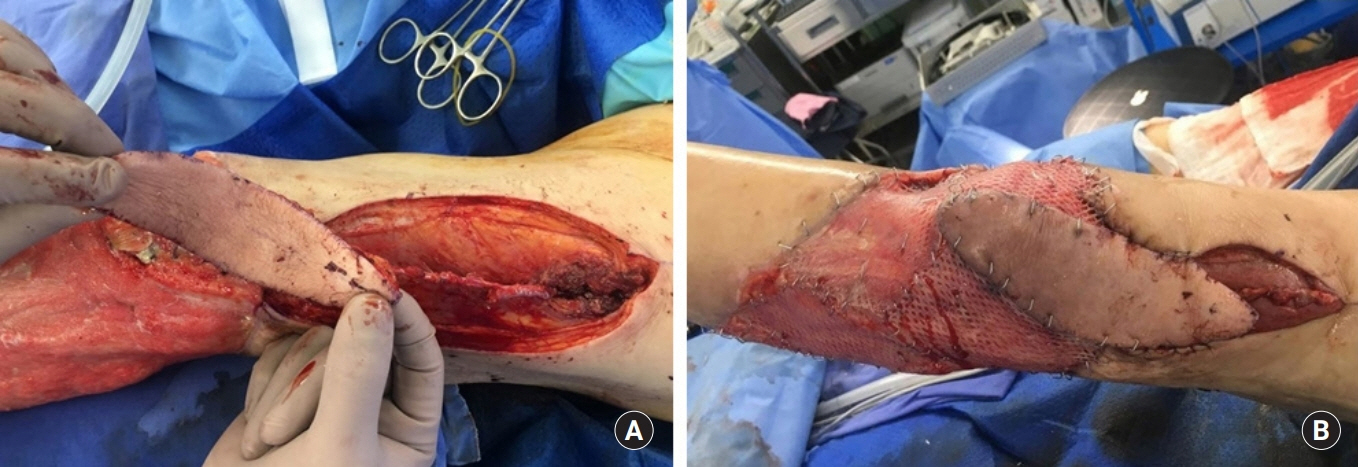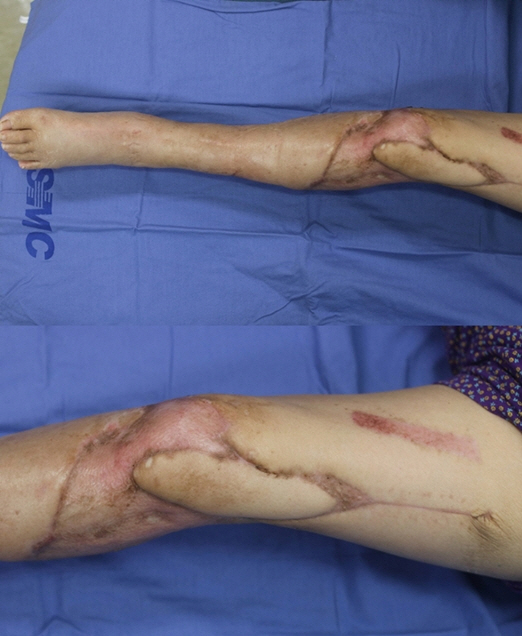Arch Hand Microsurg.
2020 Mar;25(1):55-59. 10.12790/ahm.19.0038.
Reconstruction of Soft-Tissue Defect Around the Knee Using a Pedicled Reverse-Flow Anterolateral Thigh Flap: A Case Report
- Affiliations
-
- 1Department of Plastic and Reconstructive Surgery, Kangbuk Samsung Hospital, Sungkyunkwan University School of Medicine, Seoul, Korea
- KMID: 2501112
- DOI: http://doi.org/10.12790/ahm.19.0038
Abstract
- Coverage of traumatic soft-tissue defects around the knee is a challenging problem for reconstructive surgeons though many reconstructive options are available. We planned to use a pedicled reverse-flow anterolateral thigh (ALT) flap using the distal branch of the descending branch of the lateral circumflex femoral artery (LCFA) for pedicle length extension in a patient with the ALT perforator branch originating from the proximal portion of the descending branch of LCFA. We present the successful use of a pedicled reverse-flow ALT flap to cover a soft tissue defect around the knee.
Figure
Reference
-
References
1. Song YG, Chen GZ, Song YL. The free thigh flap: a new free flap concept based on the septocutaneous artery. Br J Plast Surg. 1984; 37:149–59.
Article2. Koshima I, Nanba Y, Tsutsui T, Takahashi Y, Itoh S. Perforator flaps in lower extremity reconstruction. Handchir Mikrochir Plast Chir. 2002; 34:251–6.
Article3. Koshima I, Nanba Y, Tsutsui T, Takahashi Y. New anterolateral thigh perforator flap with a short pedicle for reconstruction of defects in the upper extremities. Ann Plast Surg. 2003; 51:30–6.
Article4. Zhou G, Zhang QX, Chen GY. The earlier clinic experience of the reverse-flow anterolateral thigh island flap. Br J Plast Surg. 2005; 58:160–4.
Article5. Zhang G. Reversed anterolateral thigh island flap and myocutaneous flap transplantation. Zhonghua Yi Xue Za Zhi. 1990; 70:676–8.6. Chung YJ, Kim G, Sohn BK. Reconstruction of a lower extremity soft-tissue defect using the gastrocnemius musculoadipofascial flap. Ann Plast Surg. 2002; 49:91–5.
Article7. Gravvanis AI, Iconomou TG, Panayotou PN, Tsoutsos DA. Medial gastrocnemius muscle flap versus distally based anterolateral thigh flap: conservative or modern approach to the exposed knee joint? Plast Reconstr Surg. 2005; 116:932–4.
Article8. Kimata Y, Uchiyama K, Ebihara S, Nakatsuka T, Harii K. Anatomic variations and technical problems of the anterolateral thigh flap: a report of 74 cases. Plast Reconstr Surg. 1998; 102:1517–23.
Article9. Wong JK, Deek N, Hsu CC, Chen HY, Lin CH, Lin CH. Versatility and "flap efficiency" of pedicled perforator flaps in lower extremity reconstruction. J Plast Reconstr Aesthet Surg. 2017; 70:67–77.
Article10. Huang YH, Hsieh TY, Lai CS, Lin SD, Chang KP. In situ pedicle lengthening of the anterolateral thigh flap. Plast Reconstr Surg. 2014; 133:85e–7e.
Article
- Full Text Links
- Actions
-
Cited
- CITED
-
- Close
- Share
- Similar articles
-
- Distally Based Anterolateral thigh Pedicled Flap in the Reconstruction of Defect Around Knee
- Inguinal Soft Tissue Reconstruction Using Pedicled Anterolateral Thigh Flap: A Case Report
- Reconstruction of Soft Tissue Defect of Knee Joint Area Using Anterolateral Thigh Perforator Flap
- Scrotal Reconstruction with Pedicled Anterolateral Thigh Perforator Flap
- Pedicled Perforator Flaps for Reconstruction of Bilateral Knee Defects: A Case Report




